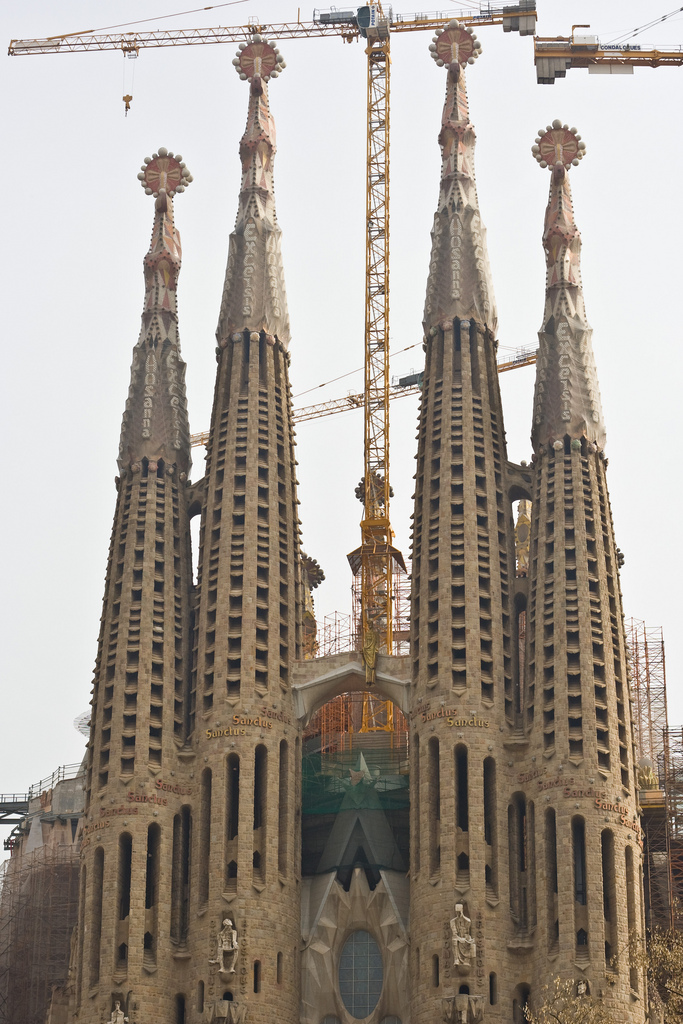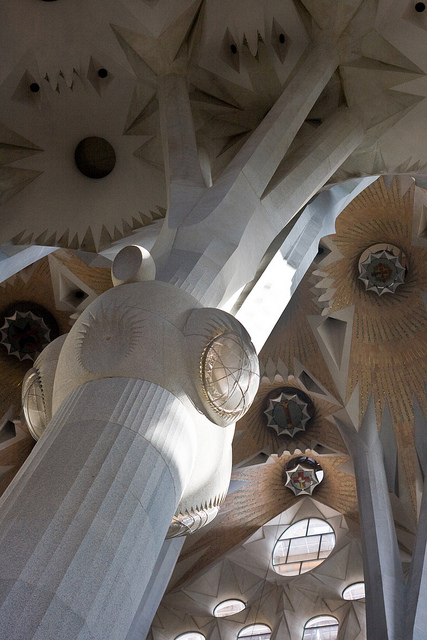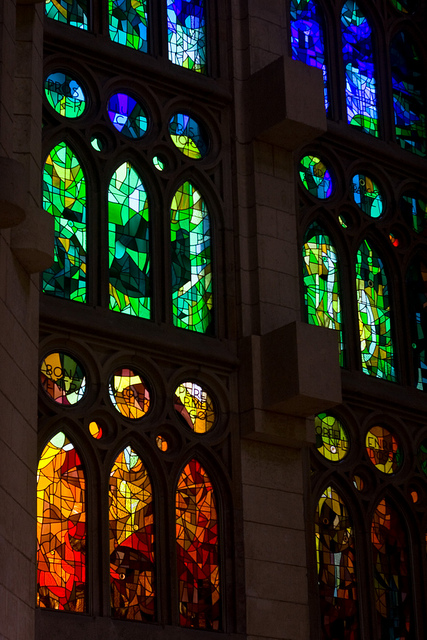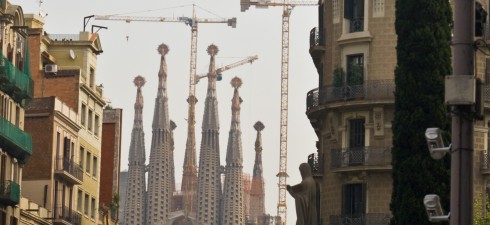 As we approached the wide junction of Avinguda Diagonal and the street on which our hotel was located, I saw the spires of Sagrada Familia for the first time. The four spires that faced us towered among cranes, with words circling up to heaven in red and yellow: ‘Sanctus, Sanctus, Sanctus’. I had seen nothing like it in all my life, and as we walked onto the square to our first full view, I felt emotional, overcome. How was it possible, that for all the times I’d looked at photographs and anticipated this place: how could its substance so overpower all previous senses I had of the building? But it did: and not just from this angle, but again and again.
As we approached the wide junction of Avinguda Diagonal and the street on which our hotel was located, I saw the spires of Sagrada Familia for the first time. The four spires that faced us towered among cranes, with words circling up to heaven in red and yellow: ‘Sanctus, Sanctus, Sanctus’. I had seen nothing like it in all my life, and as we walked onto the square to our first full view, I felt emotional, overcome. How was it possible, that for all the times I’d looked at photographs and anticipated this place: how could its substance so overpower all previous senses I had of the building? But it did: and not just from this angle, but again and again.
Later that evening, Helen and I sat on a bench outside the apse, one of the few parts of the temple completed during Gaudi’s lifetime. As the light faded, the colours of the stained glass became distinguishable, and then began to sing: the deep blues, rising to red and green. This part of the building had a very different feel to the rest: old stone, and a dignified, traditional manner. After Gaudi was killed in a tram accident in 1926, he was interred in the crypt below this part of the building, that he had dedicated his life to ushering into reality. ‘The temple cannot be built in a generation’, he wrote, and such would be the case. The next day, we would return and enter.

At present, the public is admitted to the temple in front of the Passion Façade, whose construction was entrusted to a team headed by Josep Subirachs, and begun in 1987. The grim, postmodern, angular figures are harrowing: a testament to how the generation of genocide and threat of nuclear obliteration could best conceive of the suffering inflicted on Christ’s body. The doors to that façade are inscribed with words from the gospels, with phrases and figures highlighted. A question appears in gold: ‘What is the truth?’
As we walked through those doors into the interior of the temple, we were admitted to the beautiful forest that Gaudi conceived of, which was only completed in the last few years since Helen had visited last. The vaulted ceiling was modelled after great tree-branches, and the columns stacked one kind of stone beside another, with porphyry for the four central columns, that will one day support the 170-metre (560 ft) tower dedicated to Christ. The huge columns develop their surfaces, from squares to circles, and an ever-changing number of sides as they ascend. At the end of the nave, spiral staircases ascended past the choir, which one day will fill the temple with song, accompanied by four organs.

We were lifted to the top of the towers of the Passion façade by an elevator, and slowly descended through a staircase within. From these heights, we could see all of Barcelona: the equal distance to the mountains West, and the sea, to the East. We could see workmen crafting the pinnacles covered in Venetian glass: vividly-coloured bushels of grains and fruits. To see a place of worship so alive with construction was inspiring. Modern technology meant that what was once expected to take centuries may now be completed by 2026, the centenary of Gaudi’s death. In the basement of the temple, a museum celebrating the vision of the architects showed the faces of men and women who had lived and died believing in the glory of this building, as a fitting manifestation of their faith. The mystery, beauty and complexity of Christ and His creation was the expression of this total piece of art.
On the final night of our stay in Barcelona, I left our hotel alone after midnight, armed only with my camera. I had to walk the city one more time, and see her heart again: the silent, sacred temple. I passed the almost-empty bars, with their laughter spilling into the yellow and black shadowed streets. I crossed the ten empty lanes of the Avinguda Diagonal, and approached the temple through the park, its now-lonely lamp-posts haloed in the sand. I sat and admired the silent spires of the Nativity Façade, the grandest portion that Gaudi completed before his death. The giant cypress tree, which symbolises the tree of life, overlooked the road, half-illuminated by street-lights. I remembered reading of the eventual vision, for a light that will shine from the huge central tower, the highest spire in the world. That light, Gaudi’s plan prescribed, would shine down onto the city of which it was a part, illuminating the places of God’s sleeping children, through the night.
All photography is by the author.

Love Barcelona! Love Sagrada Familia.. loved it even more with you!
I have been there twice. It is indeed amazing. Unfortunately, the first time I was 17 years old and did not appreciate anything (!). And the second time I had a 2.5 year old in tow and was therefore distracted by worries of her falling off the incredibly windy staircase or running into the busy city streets. As a result, I feel like I missed much of its beauty.
I’ll make it back some day.
I spent a day there last year. I’ve seen some pretty amazing buildings and edifices throughout the world, but La Sagrada Familia tops them all.
Something so human about the sprawling way La Sagrada Familia builds layer by layer with each successive generation. Give me this living, breathing building to worship in any day over the LDS version of the temple, so spare and austere.
I’m really excited to see how the Glory Facade and the final towers will add the mark of our generation… You’re right: the life of this building breathes through all its open doors.
When I saw the fruits and grains on the roof, however, I did think of the ceiling of the Salt Lake Celestial room. Although it’s rare, there’s a sense of abundance in some temple details. Sadly, our two temples here in the UK are as austere as they come: grey stone boxes, with a single, uniform spire.
Hi! Magnificent blog! I happen to be a daily visitor to your site (somewhat more like addict :P) of your website but I had a a doubt. I’m not really totally sure if it is the right site to ask, but you’ve got no spam comments. I get comments on a daily basis. Possibly can you help me? Thanks a lot!